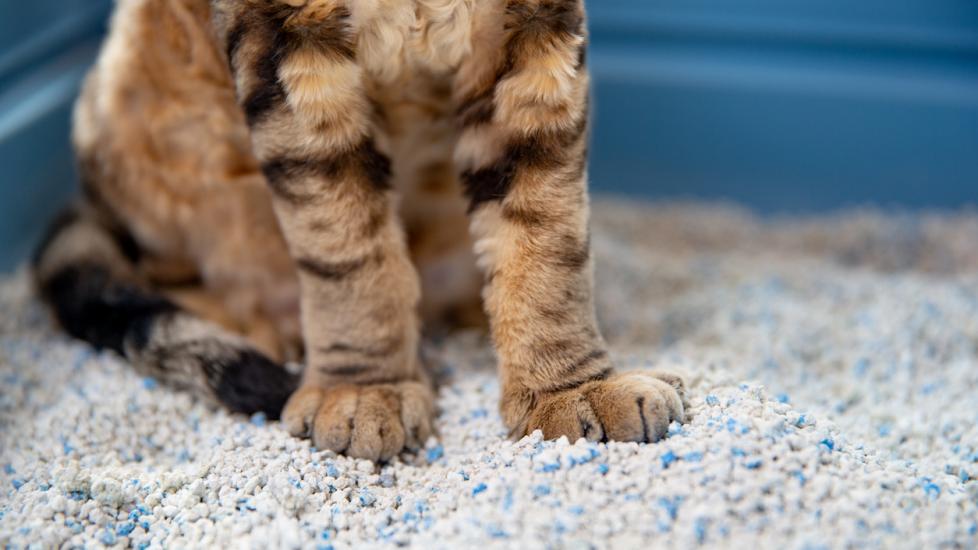Are There Eco-Friendly Cat Litter Disposal Options?
By Kate Hughes
Many pet parents are concerned with the impact that their pets are having on the environment. Maybe they’ve already adjusted their lifestyles to incorporate more sustainable products—like bamboo toothbrushes and reusable straws, taken a closer look at their recycling habits and even started to dabble in composting. But, for even the most eco-friendly pet parents, there’s one item that isn’t that easy to find a green alternative for—cat litter.
But there are green ways to dispose of cat waste and cat litter. With the right materials and a little know how, cat owners can reduce their eco-paw print and dispose of their kitty’s leavings in a way that is less harmful to the environment.
Searching for a Sustainable Cat Litter
Disposing of cat litter in an eco-friendly manner begins with the composition of that litter. “Clay litter is not the most sustainable option,” notes Ramsey Bond, a recent graduate of Colorado Mountain College in Glenwood Springs, Colorado, whose studies focus on sustainability. For her senior project, Bond worked closely with the Colorado Animal Rescue (C.A.R.E.), a nonprofit animal care organization in Glenwood Springs, Colorado, to develop animal waste composting procedures that lessened the shelter’s eco-footprint and transformed it into an overall more sustainable facility.
Bond strongly suggests that any person looking to lessen the environmental impact of their cat litter switch to a wood pellet-based product. “Wood pellet-based litters are a renewable resource and are ideal for composting,” she explains.
Tracey Yajko, canine behavior and community outreach manager at C.A.R.E., says that her organization had been using pine pellets as their go-to cat litter for many years. “We switched to pine pellets for two reasons—cost and disease prevention,” she explains. “When bought in bulk, it’s less expensive than clay-based litters, and it’s dust-free.”
While seasoned cat owners might be hesitant to change the type of cat litter they’ve been using, as cats are notoriously picky about their cat litter boxes, Yajko adds that most of the cats at C.A.R.E. have no issues with the pine pellet litter. “There are some older cats that are a little finicky about their litter, but 90 percent of our animals take to the pine litter without any issues,” she says.
To the Compost Heap
As Bond noted, wood-based cat litter is ideal for composting, which is perhaps the eco-friendliest way to dispose of cat litter and waste. But you must be very careful about reaching the correct temperature to destroy pathogens.
Unless you’re using an enzyme to help break down waste or can guarantee that the compost bin is heating to over 145°F, you don’t want to use this fertilizer in a vegetable garden. “There are some pathogens in cat waste that are harmful to humans. If you can get temperatures over 145°F, you can destroy those pathogens and the fertilizer should be safe,” Bond says.
“By combining wood and cat feces, you’re creating instant compost,” she explains. “All you need to start composting is a carbon source and nitrogen source. Wood is carbon; cat waste is nitrogen. Add sunlight, water and time, and all of those components will break down naturally.” Bond’s project launched this spring, and by summer, she and C.A.R.E. are hoping that the compost is far enough along that it can be used as fertilizer for trees and other plants.
How to Compost
Bond says that people looking to compost their cat’s waste should research their options and look into local ordinances before they begin. “There are so many different ways to compost, but the two most popular are the bucket method and starting an in-ground compost area,” she notes.
Buckets can be expensive and are only able to compost a small amount at a time, but this may not be an issue for people with only one cat. In-ground methods can handle more volume, but you should research to make sure your property isn’t anywhere near a water source. “You’ve got to check where your water table is if you live near a water source, because there can be runoff and leaching from your compost. You have to consider that you’re basically creating a mini landfill and should treat it as such,” Bond explains.
Bond suggests that anyone thinking about composting their cat’s waste read the book, “The Pet Poo Pocket Guide” by Rose Seemann. “It has so much information and really lays out all of your options as a pet owner,” she says.
Flushing Cat Waste
For apartment dwellers, composting what’s in your cat’s litter box might not be possible. However, Bond says that there is another eco-friendly way to dispose of cat waste—flushing it.
“If someone lives in an apartment, I’d say their best bet would be using a wood pellet litter and disposing of solid waste in the toilet,” she says. Keep in mind that we’re only talking about flushing the actual cat waste here.
“But if you’re going to go this route, check with local waste management companies first. You want to be sure that their treatment methods will kill all the bacteria and pathogens commonly found in cat feces,” says Bond.
But, can you flush the cat litter with it?
Bond cautions that people who live near the coasts or other major waterways shouldn’t flush their cat litter. “In coastal regions in particular, you never want to flush cat waste because it can contain Toxoplasma gondii, a bacteria that causes toxoplasmosis,” she says. “This bacteria can contaminate water and cause people to get sick.”
Keep an Open Mind
Bond says that part of the reason cat waste is having such a negative impact on the environment is that so many people are simply used to using clay litter. There are other options out there that are so much more eco-friendly. “All you have to do is be open to using them and you can decrease your—and your cat’s—carbon footprint,” Bond says.
Photo Credit: iStock/CasarsaGuru
